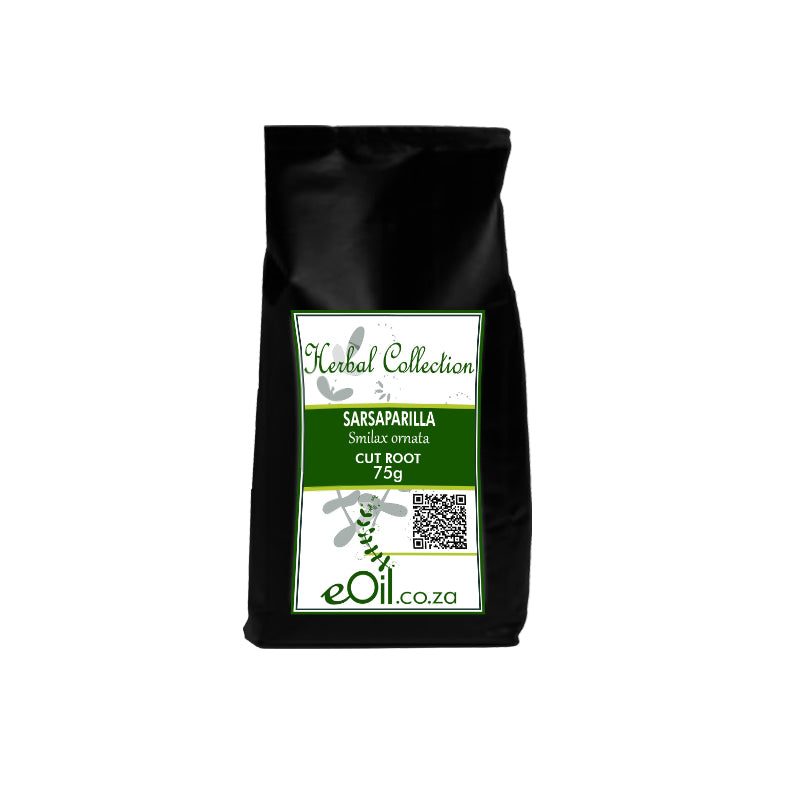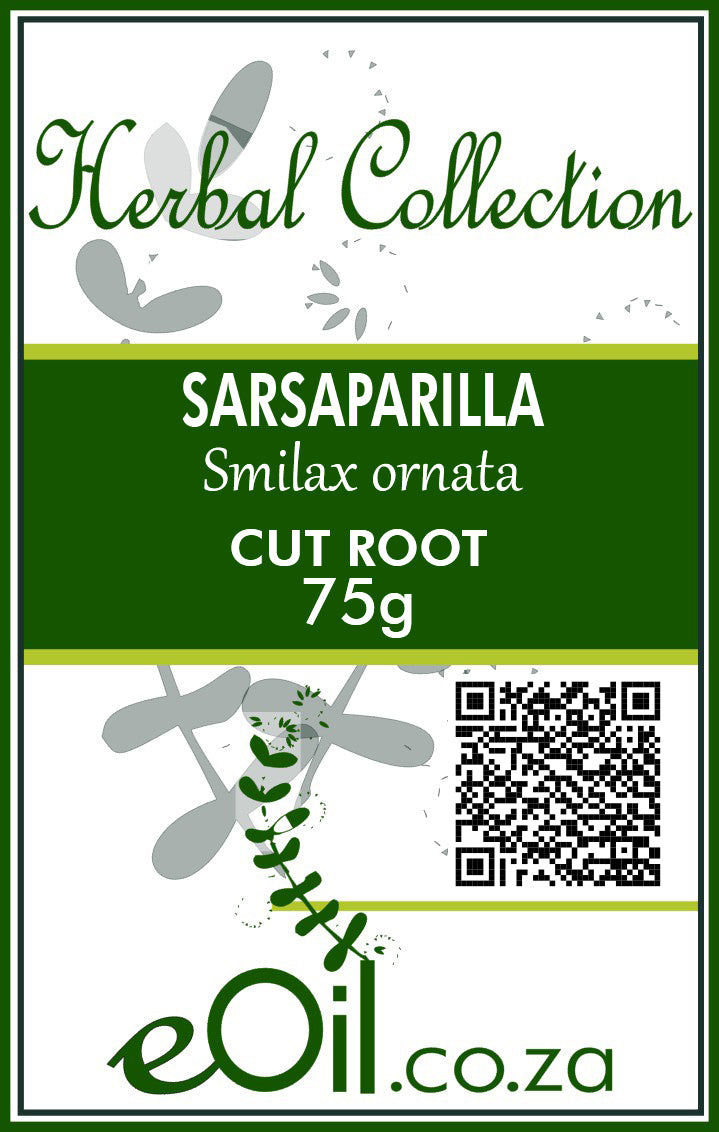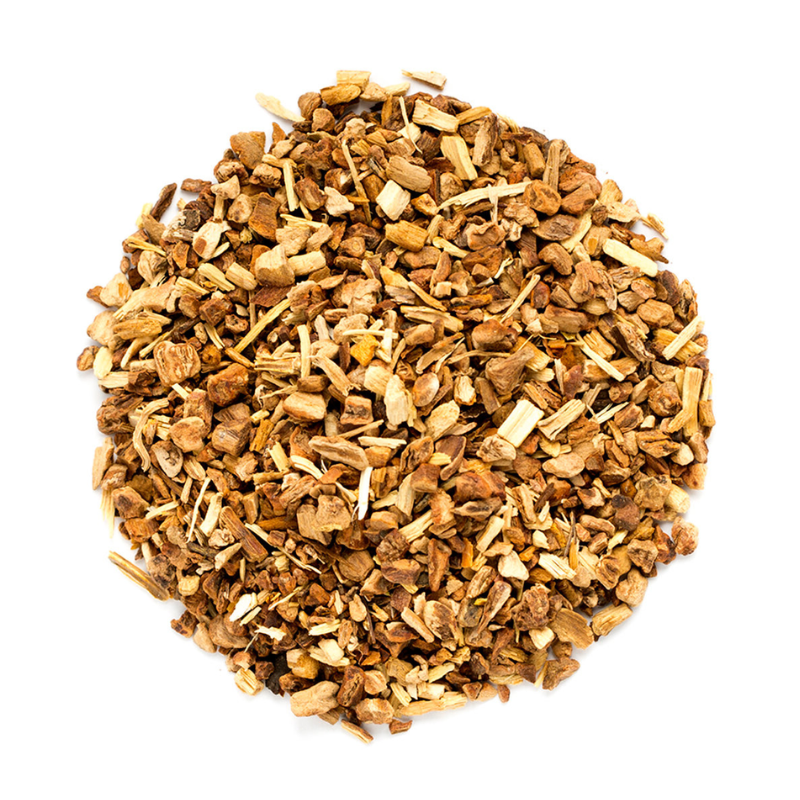Sarsaparilla Root Cut - Herbal Collection
Sarsaparilla Root Cut - Herbal Collection - 75 GR is backordered and will ship as soon as it is back in stock.
Description
Description
Sarsaparilla Root Cut (Smilax species) is a traditional botanical valued for supporting natural detoxification, skin clarity, and overall wellness.
These pure, dried root pieces are rich in natural compounds and antioxidants, perfect for herbal teas, infusions, or tonic blends.
Additive-free, and suitable for daily wellness routines.
TRADITIONALLY USED FOR
May help with
- depurative
- psoriasis
- rheumatoid arthritis
- joint pains
- increasing sweating
Sarsaparilla Root – Botanical Identification
Botanical Name: Smilax ornata, Smilax officinalis, Smilax regelii, Smilax aristolochiaefolia
Family: Smilacaceae
Sarsaparilla is a perennial, climbing vine native to Central and South America with woody stems, heart-shaped leaves, and a tough, aromatic root prized for traditional herbal uses.
Traditional Herbal Uses
- Promotes blood purification and detoxification, historically used for skin health, rheumatic and arthritic complaints, and immune support.
- Traditionally brewed as a tea or decoction to support kidney and liver function and general vitality.
- Used for skin conditions (psoriasis, eczema), joint pain, digestive health, and as a general tonic in Western and indigenous herbal traditions.
Sarsaparilla Product Comparison Table
| Product Form | Form & Preparation | Primary Uses | Absorption Rate | Concentration | Best For | Typical Dosage |
|---|---|---|---|---|---|---|
| Sarsaparilla Root Tincture | Liquid alcohol-based extract (1:5 ratio) | Fast absorption, detox, skin conditions | Fastest (sublingual) | Medium (1:5 plant:liquid ratio) | Acute issues, sensitive stomachs | 1-3 ml, 2-3 times daily |
| Sarsaparilla Loose Herb | Dried root cut for tea/decoction | Gentle tonic, traditional tea, skin/joints | Moderate (digested) | Whole plant (variable) | Custom tea blends, gentle daily support | 1-2 tsp/cup, tea/decoction |
| Sarsaparilla Root Capsules | Powdered root in vegetarian capsules | Convenient, standardized dose, daily tonic | Good (20-30 min digestion) | Standard root powder | Daily maintenance, travel-friendly dosing | 1-2 capsules, 2-3 times daily |
| Sarsaparilla Extract Capsules | Concentrated extract powder in capsules | Highest potency, therapeutic applications | Good (enhanced bioavailability) | Highly concentrated (4:1+) | Maximum strength, therapeutic use | 1 capsule, 1-2 times daily |
Important Notice
Individual results may vary. Not intended to diagnose, treat, cure, or prevent disease. Always consult a healthcare professional before beginning any herbal regimen, especially if pregnant, nursing, taking medication, or have medical conditions.
Sources are available upon request; all information is compliant with current herbal safety guidelines and quality assurance standards.
Safety Information & Cautions
- Avoid using during pregnancy and breastfeeding due to insufficient safety data.
- People with kidney disease, aspirin allergy, or asthma should consult a healthcare provider before use.
- May interact with medications (digoxin, lithium, diuretics). Consult a professional before use if on prescribed medicines.
- Possible side effects: mild digestive upset if too much is taken; rare reports of kidney irritation when used in excess.
INFORMATION
Source : http://www.wikiphyto.org/wiki/Salsepareille
Reference on http://www.wikiphyto.org
Translation in English by Google Translate (go to the page of the source linked | on Chrome cellphones go on the 3 dots on the top right and select translate in your preferred language | on laptop right click your mouse and select option translate when hoovering on the page
plant name
- Sarsaparilla , European sarsaparilla , spiny bindweed , poor man's asparagus
- Mexican Sarsaparilla = Vera Cruz Sarsaparilla
- Honduran Sarsaparilla
International Latin denomination
- Smilax aspera L.
- Smilax aristolochiaefolia Mill. = Smilax medica Schlecht. and Cham.
- Smilax sarsaparilla L. = Smilax ornata Hook. f.
botanical family
Liliaceae
- Smilacaceae
Description and habitat
- Lianoid plants, famous for their rhizomatous strain from which we collect the very long roots of the diameter of a pencil
- Smilax medica is native to Central America (Mexico)
- Smilax aspera , the European sarsaparilla is common in the woods of the South of France, its fruit is a small green globose berry then dark purple or even black when ripe
- The leaves are heart-shaped, leathery and spiny on the edges and under the main vein, the petiole bears two tendrils at its base, white, yellowish or greenish flowers, fragrant, located in the leaf axils
History and tradition
- Smilax medica = Smilax aristolochiaefolia : its root was widely imported into Europe until around 1930, because of its antisyphillitic properties
- She is called Zarzaparilla
- Its name would come from the Spanish, zarzaparrilla deriving from zarza = "bramble", and parrilla = "little trellis"
- Smilax aspera : its root was used during Antiquity in Europe as a crown to treat headaches, it was held as an antidote to poisons
- Young shoots can be eaten like wild asparagus
Parts used
- Underground part
Dosage forms available
- Sarsaparilla tincture underground part (= Smilax medica )
- Smilax aspera tincture
Usual dosages
Composition
Main components of the plant
- Roots:
- Steroidal saponosides [ 1] , [2] derivatives of sarsasapogenin [3]
- 31-Norcycloartanol [4]
- Polyphenols , tannins [5]
- Resveratrol
- Berries:
Main components of buds or young shoots
Main components of essential oil
Properties
Plant properties
- Smilax aspera :
- Antiseptic, antipruritic [8] , depurative
- Antifungal ( Candida albicans, C. glabrata, C. tropicalis [9]
- Anti-inflammatory [10] , antioxidant [11]
- Steroidal saponins are antiproliferative [12] , [13]
- Chemopreventive potential ( triterpenoids derived from cycloartane) [14]
- Saponins are diuretic , sudorific, depurative in skin diseases, and intestinal infections
- Smilax medica = Smilax aristolochiaefolia
- Formerly used as an antisyphilitic
- Hematopoietic activity, increases the number of erythrocytes, hemoglobin and hematocrit [15] , [16]
- Hypoglycemic, hypotensive, hypotriglyceridemic, decreases insulin resistance, action on metabolic syndrome [17]
- Potentialities in Alzheimer's disease ( sapogenins ) [18] , [19] , [20]
- Antioxidant [21]
- Another species, Smilax china , has hypouricemic and nephroprotective [22] , anti-inflammatory [23] , [24] , cytotoxic and anti-cancer [25] , [26] , and tyrosinase inhibitor [27] properties.
Bud properties
Properties of essential oil
Directions
Indications of the whole plant (phytotherapy)
- Degenerative arthritis and rheumatism, gout
- Flu syndromes, colds
- Dermatological diseases: eczema, psoriasis
- Flu syndromes, anorexia
- Herpes
Indications of the bud (gemmotherapy)
Specific indications of essential oil (aromatherapy)
Known or suspected mode of action
Usual formulations
Regulations
- Are in the French Pharmacopoeia list A (root):
- Mexican Sarsaparilla Smilax medica = Smilax aristolochiaefolia
- Honduran Sarsaparilla Smilax sarsaparilla
Possible side effects and precautions for use
- Can lead to kidney problems
Bibliographic references
- Aller↑ Belhouchet, Z., Sautour, M., Miyamoto, T., & Lacaille-Dubois, MA (2008). Steroidal Saponins from the Roots of Smilax aspera subsp. mauritanica. Chemical and Pharmaceutical Bulletin, 56(9), 1324-1327.
- Aller↑ Sautour, M., Miyamoto, T., & Lacaille-Dubois, MA (2006). Bioactive steroidal saponins from Smilax medica. Plantamedica, 72(07), 667-670.
- Aller↑ Kostova, I., Dinchev, D., & Ivanova, A. (2012). Tribulus terrestris L. and Smilax species–Chemistry and bioactivity. Folk Herbal Medicine And Drug Discovery, 12.
- Aller↑ Ayengar, KNN, & Rangaswami, S. (1967). Occurrence of 31-norcycloartanol in smilax aspera linn. Tetrahedron Letters, 8(37), 3567-3570.
- Aller↑ Karuza, L., Petricic, J., Pitarevic, I., & Blekic, J. (1993). Tannins and flavonoid compounds in the plant Smilax aspera L. Farmaceutski Glasnik, 49, 99-99.
- Aller↑ Luigia Longo, Giuseppe Vasapollo. Extraction and identification of anthocyanins from Smilax aspera L. berries. Food Chemistry, Volume 94, Issue 2, January 2006, Pages 226-231
- Aller↑ Delgado-Pelayo, R., & Hornero-Méndez, D. (2012). Identification and quantitative analysis of carotenoids and their esters from sarsaparilla (Smilax aspera L.) berries. Journal of agricultural and food chemistry, 60(33), 8225-8232.
- Aller↑ Khare CP (2007). Indian Medicinal Plants: An Illustrated Dictionary. Springer-Verlag, Berlin.
- Aller↑ Sautour, M., Miyamoto, T., & Lacaille-Dubois, MA (2005). Steroidal saponins from Smilax medica and their antifungal activity. Journal of natural products, 68(10), 1489-1493.
- Aller↑ Amira, S., Dade, M., Schinella, G., & Ríos, JL (2012). Anti-inflammatory, anti-oxidant, and apoptotic activities of four plant species used in folk medicine in the Mediterranean basin. Pak J Pharm Sci, 25(1), 65-72.
- Aller↑ Ao, C., Higa, T., Khanh, TD, Upadhyay, A., & Tawata, S. (2011). Antioxidant phenolic compounds from Smilax sebeana Miq. LWT-Food Science and Technology, 44(7), 1681-1686.
- Aller↑ Victoria L. Challinor, Peter G. Parsons, Sonet Chap, Eve F. White, Joanne T. Blanchfield, Reginald P. Lehmann, James J. De Voss. Steroidal saponins from the roots of Smilax sp.: Structure and bioactivity. Steroids, Volume 77, Issue 5, 2012, Pages 504-511, https://doi.org/10.1016/j.steroids.2012.01.009 .
- Aller↑ Cappadone, C., Mandrone, M., Chiocchio, I., Sanna, C., Malucelli, E., Bassi, V., ... & Poli, F. (2020). Antitumor potential and phytochemical profile of plants from sardinia (Italy), a hotspot for biodiversity in the mediterranean basin. Seedlings, 9(1), 26.
- Aller↑ Kikuchi, T., Akihisa, T., Tokuda, H., Ukiya, M., Watanabe, K., & Nishino, H. (2007). Cancer chemopreventive effects of cycloartane-type and related triterpenoids in in vitro and in vivo models. Journal of natural products, 70(6), 918–922. https://doi.org/10.1021/np068044u
- Aller↑ Velasco-Lezama, R., Claudia, GR, Rafaela, TA, & Ramos, RR (2006). Hematopoietic activity of Smilax aristolochiaefolia in vitro and in vivo.
- Aller↑ Velasco-Lezama, R., Torres, AM, Aguilar, RT, Saenz, JLF, Padilla, MF, Avila, EV, & Escorcia, EB (2009, January). Hematopoietic activity of smilax aristolochiaefolia (zarzaparrilla) in mice with aplastic anemia. In Proceedings of the Western Pharmacology Society (Vol. 52, pp. 83-87).
- Aller↑ Amaro, CAB, González-Cortazar, M., Herrera-Ruiz, M., Román-Ramos, R., Aguilar-Santamaría, L., Tortoriello, J., & Jiménez-Ferrer, E. (2014). Hypoglycemic and hypotensive activity of a root extract of Smilax aristolochiifolia, standardized on N-trans-feruloyl-tyramine. Molecules, 19(8), 11366-11384.
- Aller↑ Xia, Zongqin, Hu, Yaer, Rubin, Ian, et al. Steroidal sapogenins and their derivatives for treating Alzheimer's disease. US Patent Application No. 10/894,425, August 17, 2006.
- Aller↑ Xia, Zongqin, Hu, Yaer, Rubin, Ian, et al. Smilagenin and anzurogenin-D for the treatment of alzheimer's disease. US Patent Application No. 10/336,176, June 26, 2003.
- Aller↑ Barraclough, Paul, Hanson, Jim, Gunning, Phil, et al. 5-β-sapogenin and pseudosapogenin derivatives and their use in the treatment of dementia. U.S. Patent No. 7,138,427, Nov. 21, 2006.
- Aller↑ Park, G., Kim, TM, Kim, JH, & Oh, MS (2014). Antioxidant effects of the sarsaparilla via scavenging of reactive oxygen species and induction of antioxidant enzymes in human dermal fibroblasts. Environmental toxicology and pharmacology, 38(1), 305-315.
- Aller↑ Chen, L., Yin, H., Lan, Z., Ma, S., Zhang, C., Yang, Z., ... & Lin, B. (2011). Anti-hyperuricemic and nephroprotective effects of Smilax china L. Journal of Ethnopharmacology, 135(2), 399-405.
- Aller↑ Shao, B., Guo, H., Cui, Y., Ye, M., Han, J., & Guo, D. (2007). Steroidal saponins from Smilax china and their anti-inflammatory activities. Phytochemistry, 68(5), 623-630.
- Aller↑ Lu, YN, Chen, DS, Xiong, XZ, Tian, LQ, & Deng, JG (2004). Effect of the different extraction of Smilax China L. on adjurant arthritis in mice. Chinese Journal of Hospital Pharmacy, 24(9), 517-518.
- Aller↑ Wu, LS, Wang, XJ, Wang, H., Yang, HW, Jia, AQ, & Ding, Q. (2010). Cytotoxic polyphenols against breast tumor cell in Smilax china L. Journal of ethnopharmacology, 130(3), 460-464.
- Aller↑ Li, YL, Gan, GP, Zhang, HZ, Wu, HZ, Li, CL, Huang, YP, ... & Liu, JW (2007). A flavonoid glycoside isolated from Smilax china L. rhizome in vitro anticancer effects on human cancer cell lines. Journal of ethnopharmacology, 113(1), 115-124.
- Aller↑ Liang, C., Lim, JH, Kim, SH, & Kim, DS (2012). Dioscin: a synergistic tyrosinase inhibitor from the roots of Smilax china. Food chemistry, 134(2), 1146-1148.
- Rangaswami, S., & Ayengar, KNN (1968). Chemical Components of Smilax aspera (Sarsaparilla). J.Res. Indian Med, 3(1), 1.
CAUTION
Store in a cool, dry place, away from light. Keep tightly closed, away from the reach of Children and pets.
Do not exceed the daily dose.
This product is not intended to prevent or cure any form of illness or disease.
If you are pregnant or nursing ; If you have a medical condition or are in the course of medical treatment ; If you are programmed for theater/operation in the near future, please consult your healthcare practitioner before using this product.
This product cannot replace a varied and balanced diet and a healthy lifestyle.
This product has not been evaluated by the SAHPRA for its quality, safety or intended use.
For More Information please check our General Safety Herbal products Page

Sarsaparilla Root Cut - Herbal Collection - 75 GR is backordered and will ship as soon as it is back in stock.





